|
In the United States, we consume over 250 million pounds of garlic each year, and believe it or not, unlike 10 years ago when most of it came from California, today over 50% of our garlic comes from China. Yes. China. Where "organic" food doesn't exist. Where crops are manured with human waste. Where they force people to move far away from their homes to towns dedicated to a particular industry (toy town, electronics town, carpet town, etc.)... but the production and export of garlic from China has grown so much that they have an entire province dedicated to their stinky garlic production--Shandong. My son Lucas was the first to bring Chinese garlic to my attention last year when we were in our favorite supermarket. "Dad, look at the label on that mesh bag of garlic! It's Made in China!" He was right. I've since learned that the Chinese garlic is to be avoided at all costs for a variety of reasons. I mean, really? We can't grow our own garlic? There's even a Black Market of Chinese garlic with cartels that act just like drug dealers. In Europe, smuggling garlic in from China is a big business, often wreaking havoc on the market price of garlic. We here in the U.S. can be a pretty complacent bunch. It doesn't matter where Walmart gets the products that stock their shelves, as long as we can get it cheap. So much for Made in the USA. Sure, we complain about not enough jobs, but then go ahead and support industries that buy from China and Mexico and a host of other countries, while they close down factories and farms here in the States. Apparently, with us buying over 50% of our garlic from the China, we don't care much... as long as it's bleached white (yes, they actually use bleach), blemish free (they use many toxic chemicals that kill everything, even beneficial insects) and is cheap (they manipulate the market) and tastes more or less like garlic. Most Americans have no idea what organically grown garlic tastes like.  There's even a black garlic: Aglio Nero There's even a black garlic: Aglio Nero Italians love their Aglio! And because of that passion, Chinese garlic isn't going down easily with Italians.The total production of garlic in Italy is about 30 millions pounds, with only around 2-2/5 million pounds of Chinese garlic being imported annually. There are a few a good reasons for this... First of all, to Italians, there isn't just one generic type of garlic. Italians are used to buying fresh garlic in local open air markets. And they have many options: the red garlic of Sulmona, Polesano garlic, white garlic of Vessalico, garlic dell'Ufita, garlic of Molino dei Torti, the garlic of Resia, the Massese garlic, red garlic of Castelliri, Nubia, garlic from the Maremma in Tuscany and the Monticelli garlic from Campania. Italians have choice. Italians love choice, too... especially when it comes to their produce. The other reason why Italians aren't warming up to Chinese garlic is because their love of fresh, healthy ingredients. The Italian diet makes Italians one of the healthiest countries in the world. (Read about Italy, the Healthiest European Country HERE). In 2010 China won the dubious distinction of the most contaminated foods being exported to other countries. Their garlic contain mycotoxins, additives and colorants not approved by the European Union. Many of the irregularities are due to their garlic coming into contact with other toxic chemicals either during storage or shipment. Italians like to know where their food comes from--often from their own garden, or from a farmer they are on a first name basic with.  The surprising thing in all this is that Italians may be in for a real fight against how the European Union is warming up to Chinese garlic. In 2011, the European Union's Official Journal gave the Chinese garlic variety, Jinxiang Da Suan Protected Designation of Origin (DOP) and Protected Geographical Indications (PGI). Che cavall0! This is how they protect Chianti wine, Parmigiano Reggiano, Prosciutto di Parma and other Italian regional specialties. How could this be happening. The EU is run by a bunch of business leaders. The fat cats. The "One Percent-ers". That's why. So, Bravo! to Italians in fighting back and not letting Chinese garlic take over their marketplace. As for me, I suppose I'll just have to start growing my own. Garlic is supposed to be so easy that you can grown it indoors. I'll let you all know how that plan goes... Hey, since Lucas started this, I'll get him to plant the garlic! --Jerry Finzi
0 Comments
When people picture Venice, aside from the canals, they will inevitably think of the iconic Campanile in St. Marks Piazza. What they don't realize is the tower standing today was a replica... rebuilt after it collapsed in 1902 after suffering centuries of damage from earthquakes, rising water levels and lightning strikes. Its full height of 98 meters of brick and stone collapsed under its own weight into a huge pile of rubble in Piazza San Marco on a July morning... the only casualty, a cat. The same evening, the Venice commune council voted to rebuild--stone by stone--exactly how it looked before the collapse. The work began in 1903 using the stone and brick from the original structure. The newly erected tower was rededicated in April of 1912. An amazing feat. But of course, even back then, the Campanile was one of the jewels of Venice... a premier stop on one's Grand Voyage through Europe. It was a money-maker, so there was no question about it being rebuilt ASAP. Throughout history, historic structures have been cherished, ruined, loved and rebuilt by people who are proud of their own history. I have seen entire towns in Europe that have been rebuilt in historic accuracy even after World Wars. This bond in Italy is a powerful one which connects the everyday citizen to the ancient Romans, Greeks and Etruscans. Today, after the horrific loses in both life and architectural history from the earthquake of two days ago, Italians have to band together and come to a conclusion that the losses of such beautiful and historic treasures such as Amatrice (the "Town of 100 Churches") and other hill towns in the effected area are totally unacceptable. For example, Amatrice was voted one of Italy’s most beautiful towns last year and was cherished for its Cento Chiese (100 churches) filled with frescoes, mosaics and sculptures. Half the facade of the 15th-century church of Sant’Agostino has collapsed, taking with it the beautiful rose window. They should not allow these historic gems to suffer the same fate as other earthquake damaged towns that have come before them.... turning them into de facto ghost towns. After all, many of these, although beautiful in their own right, were fairly poor without the deep pockets of the likes of Venice. But I argue that rebuilding and restoration of these historic structures and villages should be done as a tribute to the souls lost in this tragedy. I have seen the pride on Italians faces all over Italy for the wonderful little hilltowns they live in. Each is unique in some way--and all have enormous beauty. The people whose lives were lost can never be brought back, but Italy should band together and give tribute to them by rebuilding the homes they treasured so much... where they lived, laughed, sang, ate wonderful local food, held their sagre (festivals), raised their children, honored their ancestors and eventually lost their lives to a cruel act of Mother Nature. Here are some photos of what the three hardest towns used to look like--before the quake... Rebuild these towns. No more ghost towns. Honor the memories and lives of all who left their homes this week for all eternity. Never forget. Do not abandon those left behind... --Jerry Finzi Copyright 2016, Jerry Finzi/Grand Voyage Italy - All Rights Reserved  Pescara del Tronto Pescara del Tronto UPDATE--August 25th, 2016: Although Amatrice's 13th century campanile tower is still standing, it's bell was knocked loose and its clock is stuck at 3:39, the time of the quake. Aftershocks have sent stones falling from the tower as late as Thursday--the danger is still very real. Over 250 people died and hundreds more were injured, with many more still trapped in the collapsed buildings. One hotel in Amatrice had over 70 people staying there--the hotel had completely collapsed. Aside from Amatrice, three other towns were also seriously affected... Accumoli, Pescara del Tronto and Arquata del Tronto. There are also dozens of hamlets in the area--small clusters of houses which are usually incorporated into nearby larger communes--that have yet to be reached by rescuers. Aftershocks are still occurring in the affected areas, hampering rescue teams. One CNN reporter was streaming live on Facebook when suddenly the house immediately behind her collapsed. Many residents that survived are telling frightening tales of crawling out of their crumbled homes through dust, rocks and broken furnishings. Many were thrust into the night wearing only pajamas coated with foul smelling dust... replaced with clean clothes by their neighbors other volunteer rescuers. People have "lost everything", including family members, friends and neighbors. Although the elderly have spent nights in emergency tents, others are forced to stay out in the open. The temperatures in this mountainous region tend to get very cold in the evenings. As aerial photography shows, in some towns the more serious damage occurred to historic centers of towns where buildings are from 400 to 600 or more years old. In newer built areas, damage was not as severe. In the past, towns like these struck by severe earthquakes have become ghost towns, with the populations moved to new-built towns near their original location. Italy does not have a successful record of rebuilding after such earthquakes. Their economy can't afford it. Former residents fear rebuilding and moving back to their homes which sit right on top of obviously active geological faults. About 8,300 people who were forced to leave their houses after a deadly earthquake in L'Aquila in 2009 are still living in temporary accommodation. When we visited Italy we passed through several "ghost towns" that have been abandoned after having gone through such quakes. The people still own their properties, and might still spend time there tending their gardens, olive and nut trees, but at night go elsewhere to sleep. This quake was felt in a wide area of central Italy... some in Rome reported being terrified as their hotel rooms shook for as long as 30 seconds. --Jerry Finzi August 24th, 2016 -- "A 6.2-magnitude earthquake hit central Italy on Wednesday and was felt in Rome some 150 km (90 miles) away", the United States Geological Survey and AFP journalists said. The US Geological Survey (USGS) reported that an earthquake occurred 10 kilometres (six miles) southeast of Norcia, 75 km (47 miles) southeast of Perugia and 45 km (28 mi) north of L'Aquila, in an area bordering the Umbria, Lazio, and Marche regions.  photo by Massimo Percossi photo by Massimo Percossi At the time I'm writing this, around 10:30 am, Eastern Time in the U.S., it's been reported by Italian civil protection authorities that 73 people have been killed in the earthquake. Aerial photos of villages in the region show large proportions of hilltop villages have crumbled with many people missing under the rubble. Sadly, the numbers of dead are expected to rise dramatically. In Amatrice, one hard hit town, there were a larger number of people in town preparing for their annual Pasta Amatriciana Festival this coming weekend. Officials fear more injuries and deaths because of the larger than normal number of people in the town at the time. The additional fact that the quake hit during the middle of the night makes matters even worse. 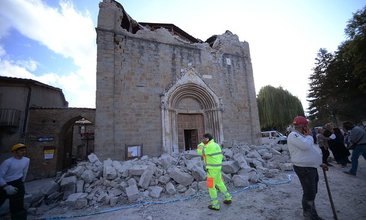 Sant’Agostino Church in Amatrice was badly damaged Sant’Agostino Church in Amatrice was badly damaged Amatrice's mayor, Sergio Perozzi was heard on RAI radio saying, "The roads in and out of town are cut off. Half the town is gone. There are people under the rubble... There's been a landslide and a bridge might collapse." He then added, “The town isn’t here anymore.” Italy's Civil Protection agency described the earthquake as "severe". Teams from the Italian state police have come into the affected area to prevent looting. Earlier Italy’s forestry police told AP that they had extracted dozens of people alive from the rubble in the town of Pescara del Tronto. News footage from the hill town showed rescue workers being winched from a helicopter. But there have also been reports of scores dead in the towns of Accumoli and Pescara del Tronto. We can only hope and pray that our Italian cousins get through this natural disaster... with the help of all of us, I believe they can and will... Click the photo below to donate to the Italian Red Cross. --Jerry Finzi To donate to the Croce Rossa Italiana in dollars and English, go HERE. In this video, baroque concert guitarist, Rolf Lislevand is playing a the priceless Sabionari Guitar, built in 1679 by Antonio Stradivari.
The Sabionari is the only Stradivarius guitar in the world that can still be touched or played. Having become famous for the construction of the best violins in the world--today sold for millions of dollars--Stradivari also built guitars, the one of which Rolf Lislevand plays in this video the only playable Stradivarius guitar from the five left in the entire world. The instrument belongs to a private collection and is exhibited in the Museo del Violino di Cremona, as part of the "friends of Stradivari" project, an international network of collectors and enthusiasts collaborating with the Museum for the preservation and enhancement of the artistic heritage of Stradivari instruments. by Jerry Finzi, February 7, 2016 (Read the UPDATE at the end of this article about Dion signing my son Lucas' guitar!) When I was a kid, there was no better tune on the radio for a young, hip kid trying to get girls to notice him than The Wanderer. The man singing that song was Dion DiMucci, better known as Dion... of Dion and the Belmonts, do-wop fame. His voice was edgy with its phrasing... of the streets... rougher than the silky smooth, clean shaven voices at that time--even though his own look was clean shaven. Somehow, I saw through all that hit-factory polish. He sang of real life experience. He wasn't so much singing a song as much as teaching me a life lesson. When he sang about Runaround Sue, you knew two things... you wanted to find a girl like that to have a sweet taste of what passion is really about, but at the same time you just knew you didn't want that kind of girl for your forever gal. You also knew that you needed to find that place he talks about in Lovers Who Wander... you just had to get there somehow. Perhaps he was giving us the address in his early bluesy version of Kansas City... at "12th Street and Vine". "I have a full life off The Road. I was never in it for the money or career. That's why I'm comfortable with myself. I know who I am out of the spotlight." When I finally fell for that first girl--and fell hard--I lamented with Dion, Why Must I Be a Teenager in Love? He taught me that real men can--and do--cry, but only for the truly important things. Then when I finally had a chance to be alone with "my girl", walking along the Palisades Cliffs overlooking the Hudson River where I grew up, with that magnificent, nighttime twinkling view of the Manhattan skyline... testing out each others' romantic limits on one of the wooden benches... I'd find myself asking her to Stay Just a Little Bit Longer. And when Donna the Prima Donna broke his heart, he gave solid advice to me about how to handle that type of inconsiderate, Italian princess. I've had my share of those... and learned how they aren't worth the effort. Dion taught me that when life kicks me down, I have to get up and keep on keeping on. A smooth, clean a capella, impromptu rendition of The Wanderer Not many people know that Dion nearly lost his life during the infamous Winter Dance Party rock and roll tour with Buddy Holly, Ritchie Valens, the Big Bopper and other performers. On a frigid February 3 in 1959, after a concert stop in Iowa, Holly and others chartered a flight to the next venue rather than travel on the cold tour bus. Dion was invited to go with them, but said he didn't want to spend $36 for the flight--the same monthly rent his parents paid their Bronx apartment--he couldn't justify the indulgence. The plane crashed, killing all on board. It was dubbed "the end of Rock and Roll" by many at the time. It profoundly gave him a new outlook on life, but proved not to be the end of rock. This video is amazing... Dion paints a portrait of what it was like growing up in the Fifties--with some heavy hitters along for the ride: Lou Reed; Paul Simon; Joan Jett; guitarist Dave Edmunds; Dire Strait's drummer, Terry Williams; Phil Chen on bass; and Rolling Stones keyboardist Chuck Leavell. As the sixties turned from do-wop to pop to mod to psychedelic and the madness in the world turned sweet, often ethnic, Kumbaya folk songs into full blown protest songs, Dion taught me another lesson of peace. With his haunting Abraham, Martin and John he compelled me into feeling the pain of the assassinations of the best of us--Lincoln, King and Kennedy--and perhaps even to make my own personal statements and stance against the madness. He continued to play music all through the rest of his life, but of course never with the pop star status as when he wore the shark skin suits and sang "dum-da-didy-do-wa-diddy" skat lyrics of do-wop. But he grew as a man and a musician and is now considered one of the best blues singers/guitarists in the world. This is what I love him for, musically speaking... he took the a Capella echoes of the candy store entrances and alleyways and the grittiness of the street, along with the heart of his Italian upbringing and merged it into his blues playing. Rightfully recognized for the talent he gave to the music scene, Dion was inducted into the Rock & Roll Hall of Fame in 1989. Bun nowadays, and at this stage of my life, I identify more with the blues songs he sings, like the blues classic Built for Comfort (I'm Not Built for Speed). About an aging man, somewhat overweight, but still passionate inside his heart and mind. That's the blues, Man. Yes... Italians can play the blues, too. We've had our own share of discrimination and loss and suffering in our heritage. Dion expresses that, but he also still expresses the blues we all feel in the course of finding love--and losing it. And this brings us to the present day... Dion is still valid, poignant and effective as ever, as evidenced by his recent New York is My Home featuring Paul Simon. His voice is clear and sweet as ever. Take the time to sit back and enjoy a great Do-Wopper, Rock 'n Roller, Bluesman, singer-songwriter and Italian-American... please watch and listen to the videos I've included in this article. You'll thank me for it. Enjoy... --Jerry Finzi UPDATE: Dion Signs Lucas' Guitar at Morristown, NJ Concert --July 29, 2016 After writing this article about how Dion's music influenced my life, Dion's publicist contacted me and complimented me on the sentiments and asked if he could re-post it. As an exchange, I told him about Lucas' guitar with a growing collection of famous musicians' signatures on it (James Taylor, Steve Martin, Loudon Wainwright III, Jorma Kaukonen of Hot Tuna fame, Doc Watson and more...). I told him how Lucas was a big fan of Dion's early music and how he would be thrilled to get his signature. He then emailed and said "Dion would be glad to sign your son's guitar". All we had to do was get it to him at one of his appearances. It took a while, but finally Dion was going to perform at a venue that we visit for concerts: the Mayo Performing Arts Theater (MPAC) in Morristown, NJ. I booked the tickets a while back and last night we attended. With a copy of the emails in hand and Lucas carrying his guitar and putting on his best 12 year old puppy eyes, we kept our fingers crossed. We've been through this before... overly protective security in such events or absolute "NO" from a performer's manager. Things didn't look good as his publicist informed me the day before that Dion's manager was "very, very, very" protective of Dion. Ok... so we started in tracking down the theater's stage manager and he promised to get the email copy (along with a copy of this article to refresh Dion's memory) backstage--but no promises. After the concert we should wait by the stage-left door. The concert was fantastic and Dion didn't disappoint. He played a myriad of songs--old and new. He played his new hit New York is my Home, Runaround Sue, the Wanderer and a solo acoustic blues favorite of mine, "Built for Comfort" about a rotund man built for comfort, not for speed but never disappoints with the ladies. Lucas had a ball. He loved all the songs and rocked out. Then the end came... and we waited at the stage-left door with a bunch of Brooklyn 75 year old "goombas"--old buddies of Dion (we supposed), and a clean cut VIP couple with their three pre-school kids that had all the earmarks of a congressional family. After the theater cleared out and the roadies had nearly emptied the stage, the stage manager came out and ushered up backstage. The first two groups we having quick chats and photo ops with Dion while we waited in the backstage hallway... but then it was out turn... Lucas was so excited when he saw HIM. Dion was very nice about it all when I introduced Lucas to him... taking his guitar in his hands and then playing an impromptu blues song with Lucas' name in it! Lucas was star-struck, for sure. Then he asked where Lucas wanted him to sign, and signed it just above the sound hole. I asked to take a photo with my smart phone and the stage manager shoved me into the shot. What a memory! Lucas left the theater in the light rain wide awake (it was 11:30 pm.... way past his normal bedtime) stunned, "I can't believe that a Rock n Roll Hall of Famer just hugged me!" He wants to save the Sharpie that Dion used to sign his guitar. He wants to never wash the T-shirt he was wearing. What a kid. I'd do anything for him... like jump through a lot of hoops to get a rock star's signature on his guitar. Thanks, Dion. Lucas is glowing this morning.... --Jerry Finzi There's been a lot of buzz lately about a new study by the Italian research journal, Nutrition & Diabetes, that making pasta a regular part of your diet can help keep you slim and healthy. Italians do have pasta pretty much every day as a part of at least one meal, and in general, Italians do carry less weight around than their Italian-American cousins. The Nutritional & Diabetes journal is an open source publication with a large editorial board with around 30 members--only one of which I noticed was Italian. However, the specific study with the overwhelming title of "Association of pasta consumption with body mass index and waist-to-hip ratio: results from Moli-sani and INHES studies", was in fact compiled by a team of 10 Italian researchers. The study was limited on one hand--two-thirds of the study was based on the diet of the small Molise region in southern Italy (just above Puglia) with only one third covering the rest of Italy--and broad-based on the other--the sampling covered more than 23,000 Italians. We Americans have always considered pasta as a delicious--albeit it--fattening food. The way Americans typically consume pasta--overcooked, and over-sauced, while filling over-sized dinner plates--perhaps that impression is correct. But for the sampling of Italians in the Moli-sani and INHES studies, the opposite seems true: Their conclusion was that "as a traditional component of a Mediterranean diet, pasta consumption was negatively associated with BMI (body mass index), waist circumference and waist-to-hip ratio and with a lower prevalence of overweight and obesity". In addition to this, another study published in Today’s Dietician (Busting the Top 10 Carb Myths) claimed that pasta can be made into a more healthy carbohydrate source only if it’s cooked al dente, as Italians prepare it. It goes like this: Eating your pasta al dente is important because the digestive enzymes in the stomach take longer to break down the al dente pasta's starch into sugars, so they are released more slowly into the bloodstream. On the other hand, when you overcook pasta, the softer pasta has a higher level on the Glycemic Index (GI). A given starch's GI indicates how fast glucose (sugar made from carbs) is absorbed into the bloodstream. Carbs with a high GI can be bad for you because because blood sugar taxes the pancreas, and can lead to diabetes and obesity. Al dente pasta is slowly digested, releasing less sugar into the bloodstream. "Ok", you say... so you'll just eat your pasta like Italians do and everything will be fine. You'll have a license to eat pasta to your heart's content. Not so fast, Marco Polo! You see, you have to look closer at how Italians eat pasta...
Some tips for healthier pasta
I'm not saying that we don't all over-indulge from time to time... I mean, hey, Lisa and I (and Lucas is learning, too) cook far better than most restaurants, so it's hard to resist having "seconds" in our house. Remember, the whole point of my blog is taking a Grand Voyage even if you aren't in Italy... Think Italian, cook like an Italian with simple ingredients, and when you dine, eat and drink like an Italian. You'll more than likely be healthier if you do... --Jerry Finzi You can also follow Grand Voyage Italy on: Google+ StumbleUpon Tumblr Copyright Jerry Finzi/Grand Voyage Italy - 2016 Here is a slideshow of images of Italy from the 1890s that used the very first color printing process called Photochrom, a technique which produced up to 6 limestone lithographic printing plates from original black and white photographic negative plates. Although at the time, an actual photographic color process (direct from cameras) was being developed, this was a much more affordable process to produce affordable postcards for wide distribution. Enjoy the look back in time...
Funiculì, funiculà was written in 1880 by Luigi Denza. The text of the song was inspired by the opening of the first cable car built in 1879, to reach the top of Mount Vesuvius. The song describes the advantages offered by the new means of transport, which allows tourists to climb, without effort, to admire the view from the summit of the ancient volcano.
Over time, the melody became famous all over the world. Click HERE for more on Italian funiculars. Non puoi insegnare niente a un uomo. Puoi solo aiutarlo a scoprire ciò che ha dentro di sé
You cannot teach a man anything, you can only help find it within himself. --Galileo Gailei  In 1894, Coca Cola opened it's very first bottling plant. The first Cokes were sold to the public in 1886 at the soda fountain of Jacob’s Pharmacy in Atlanta, Georgia in the United States. In Italy, in 1927, Romana Acque Gassose opened the first Coca-Cola manufacturing and bottling plant in Italy. This was followed in the 1930s by the bottling companies SRIBEG in Genoa and STIB in Leghorn, and by FAMIB in Milan, which manufactured and marketed soft drinks under The Coca-Cola Company trademark. The independent bottling companies subsequently multiplied to the point where they were in a position to distribute Coca- Cola products all over Italy. In 1995, The Coca-Cola Company, global leader in soft drinks boasting 4 of the world’s 5 biggest brands (Coca-Cola, Coca-Cola light, Diet Coke, Fanta and Sprite), decided to handle its Italian operations directly and accordingly bought the 11 bottling companies located in the north and center of the country... by 1998 there were 16 such plants.  When we visited Italy, Coke was everywhere. For me, I drank Fanta Aranciata... in Italy, a totally different drink than Fanta here in the States. In the U.S. it's a bright, artificial orange color with an overly sweet, chemical taste. In Italy, it's actually made with orange juice. It's fresher and more natural tasting--imagine orange juice and seltzer. I loved it. But for my boy, Lucas and wife, Lisa, once in a while they needed a Coke fix. Lucas loved Coke Zero... he said it tasted the same as here, but Lisa said it was less sweet. In general, sodas in Italy are very different... and they usually are less sweet. Italians like more fruity, sour flavors--bitter too. But make no mistake about it... you'll find Cokes everywhere in Italy.  Saverio, sun-worshiper Saverio, sun-worshiper This is a photo of the Hoboken, New Jersey harbor... "the docks"... in 1910. One of the busiest of its piers was where the Holland-American Line berthed its ships, bringing immigrants from Europe. At the time, Hoboken, was one of the busiest ports for immigrants entering the U.S., and Ellis Island was a short ferry trip downstream, with Manhattan seen on the other side of the Hudson River. Before reaching these docks, immigrants would pass Liberty Island where the Statue of Liberty held her welcoming torch... My father, Saverio Finzi, emigrated to the U.S. in 1917 when he was just 4 years old, with his father, Sergio, mother Caterina (Deceglie), sister Antonia and brother Anselmo. On the same ships manifest are listed many others from my father's hometown of Molfetta in Puglia. On the ships manifest for Sergio's final trip with his family, there were no fewer than 13 passengers listed from his hometown of Molfetta. Sergio, also had two previous voyages to American--in 1907 and 1909--and between these two other passages were listed another 20 passengers from Molfetta. Large numbers of Molfetese settled in Hoboken, making it--even to this day--the sister city of Molfetta. Both towns even celebrate matching festivals each year to honor the Madonna dei Martiri (Madonna of the Martyrs). Life in Hoboken, although much better than life during the hard times in Southern Italy at the time, were still difficult. My father tells of walking the railroad tracks picking up pieces of coal that had fallen from the steam locomotives, and then taking them home to his mother to burn as both a source of heat and cooking in their cast iron stove. Saverio had to leave elementary school early--by the 5th grade--just so he could help support their growing family (Sergio and Caterina eventually had six children). Later on, when he was a teenager, he and his brother bought what Dad always called his "three legged horse" (lame in one leg) and a cart so they could sell fruit to the passengers and seamen down at the harbor. He amassed a large collection of coins from perhaps a dozen or more countries from all around the world during this period. All from customers that bought fruit from him... I still have the coins today and often get them out to show my son, Lucas, from time to time. Dad loved selling fruit and vegetables--and meeting people. Everyone loved him. He also made the most beautifully hand-written signs for the store window. He might have been a sign painter in another life. But meeting and chatting with his customers was his best attribute. Perhaps this is why he always was a fruit and vegetable man his whole life, and later on gained more skills to also become a beloved "deli-man". Some of his customers lovingly dubbed him, "My Baloney Man". 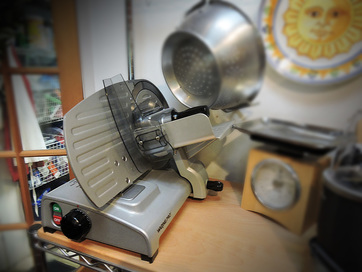 I just had to have a deli slicing machine... I just had to have a deli slicing machine... He not only knew how to pick the best produce (and taught me to smell, rather than squeeze), but he could also make fantastic baked ham, fist-sized polpette (meatballs), and the most amazing roast turkey and baked lasagna. He taught me how to cook about as good as he did. I even have a deli meat slicer in my kitchen, in honor of My Baloney Man. Hoboken must have been a wonderful place to grow up for him (my family moved out of Hoboken when I was 18 months old). He swam in the Hudson by jumping off the piers. He told me that one very cold winter, he and his pals walked all the way across the frozen Hudson River to Manhattan, spent the afternoon, and then walked back across the ice. Dad told me that he used to find "quicksilver" (the liquid metal, mercury) pouring out of cracks in the cliffs overhanging the town. And further on, the same steep cliff had an amazing inclined plane, locals called "the Wagon Lift", which my father told me used to lift horse and wagons up the cliff from Hoboken into Jersey City. He fished for eels and caught crab from the river--and later taught me how. He loved the smell of the river, which I am certain reminded him of the hometown he described so well to me... "Molfetta was filled with white houses all around the harbor. There were always sail boats bobbing up and down and the smell of fish..." Eventually, Lisa, Lucas and I would pay homage to Saverio by visiting Molfetta. It was just as he described it. I wish he could have come with us... oh, that's right. He did. --Jerry Finzi  If only Americans would hold national referendums--perhaps we could really get things done! If only Americans would hold national referendums--perhaps we could really get things done! It's difficult for an American to even consider having a king and living in a monarchy with a king or queen. (Hear that, Trump?) I mean, it was well over 2oo years ago when the Declaration of Independence was signed and we went to war with the British to get out from under the robes of royal rule. Being ruled under a monarchy has been forgotten from our collective memories. But for Italians--even though it seems like their "country" has been there 2000 years before the united States, we must be reminded that their many independent city-states were only merged into one Italia by Garibaldi in the late 1800s. Then, after WWII--when the Nazis and Mussolini and all traces of fascism were at last gone from la Bella Italia--there was another big decision for Italians to make: Did they want a monarchy or a republic? It's a little like the Romans trying to decide between their Republic and the Empire. (FYI, in time, the Roman Empire crumbled...) So, Italians find themselves each June 2nd celebrating the Festa della Repubblica, the day commemorates the national referendum held in 1946, in which the Italian people went to the polls in record numbers to decide on the form of government they wanted. There were 12,717,923 votes cast for a republic against 10,719,284 for the monarchy.  You see, up until that point, Italy had been ruled by the House of Savoy, one of the oldest royal families in the world. Their royal family started way back in 1003 AD in the Savoy region of Italy, and reached a kingly level in 1713. A branch of the family, the House of Savoy from Carignano ruled from the Unification in 1861 until June 2nd, 1946 when Italians decided they wanted to have a say in their own future. The Savoyard Kings of Italy were Victor Emmanuel II, Umberto I, Victor Emmanuel III, and Umberto II. The last monarch ruled only for a few weeks before being deposed following the Constitutional Referendum of 1946, after which the Italian Republic was proclaimed. After the election, all male descendants of the House of Savoy were sent into exile. Festa della Repubblica is celebrated on June 2nd each year with as much fanfare as Americans on Independence Day. A huge military parade is held in Rome with the Tricolori (tri-color) flag represented by colorful aerial displays over the Eternal City. Most Italian towns and villages also have festive celebrations on this day. Many point out that Italy is not as cohesive a nation as they could be, with some regions getting more perks than others, and with more people speaking their regional dialect than any official "Italian" language. But consider that over 23 million Italians came out to vote for the Republic in 1946... they might not have known it then, but they were finally becoming una nazione unita... --Jerry Finzi Starting with the Invasion of Sicily in July of 1943, and culminating in the June 6, 1944, D-Day invasion of Normandy, Allied forces took the fight to the Axis powers in many locations across Western Europe. The push into Italy began in Sicily, but soon made it to the Italian mainland, with landings in the south. The Italian government (having recently ousted Prime Minister Benito Mussolini) quickly signed an armistice with the Allies -- but German forces dug in and set up massive defensive lines across Italy, prepared to halt any armed push to the north. After several major offensives, the Allies broke through and captured Rome on June 4, 1944.  Standing in front of the Italian Army’s Caudron G.4, during The Great War is Aldo Finzi. He was a non-practicing Jew, aviator, sportsman, and then politician. Later, he was companion in arms (or rather, flight) of the poet Gabriele D’Annunzio on the epic flight over Vienna in 1918, with 11 other airmen to drop several hundred thousand poetic, propaganda leaflets appealing to the citizens of Austria not to go to war. After 1920, Finzi became a close collaborator of Il Duce, Benito Mussolini, and became a member of the first Mussolini cabinet, founder of the Regia Aeronautica as independent air force and was involved in the notorious “Matteotti affair”, involving political intrigue, government fraud and murder. He was born on 20 April 1894 at Legnago, near Verona, and was the son of a wealthy Jewish fabric mill owner. He didn't observe any religion and in his early career was a sports journalist. Aldo Finzi attended Aviator’s World at Milan, became a balloonist, and took part in ballooning and motorcycle competitions. In the early part of WWI, Finzi transferred to the Italian Army’s air squadron, and in 1916 became a licensed airplane’s pilot. He was awarded two silver medals for distinctive service.  After dismissal from the Army, he entered politics and was elected in 1921 was elected to a seat in the Kingdom’s Parliament, which was Fascist. He worked with Mussolini and became Deputy Secretary of the Interior. Aeronautics being his primary interest, in 1923 Mussolini appointed him as Deputy Commissioner for Aeronautics (under Commissioner Mussolini). Finzi then created Regia Aeronautica (Royal Air Force) as independent armed force, in addition to both the Aeronautic Academy and the Aeronautical Corps of Engineers. Aldo Finzi's End... Finzi’s demise came when, still as Deputy Secretary of the Interior, was involved (whether true or not) in the “Matteotti affair”, when Socialist leader Giacomo Matteotti was abducted and killed by a Fascist squad on 10 June 1924. Most think these were trumped up charges because it was becoming clear that Finzi was turning against the Socialist/Fascist movement. Mussolini made him resign within the month. He retired to a life in agriculture, growing tobacco, but was still active in the aviation world and retained his pilot’s license. When the Italian government enacted its racial laws in 1938, Finzi officially declared to be a Catholic. (Finzi is a very old, classic Jewish family name.) This all happened as Finzi was trying to distance himself from Fascism and Mussolini. It all caught up to him when, in 1941, he was arrested and imprisoned on an island fortress, while being thrown out of the National Fascist Party. In 1943, Finzi took steps to return home and back into the Roman Jewish community as a partisan. In February, 1944 Aldo Finzi was arrested by the SS at his home at Palestrina and transferred to a prison in Rome. In retaliation for a bomb attack which claimed the lives of 33 members of the German Polizeiregiment Bozen on March 23, Finzi was executed on the next day... March 24, 1944. Today Aldo Finzi rests at the Fosse Ardeatine Memorial Cemetery together the other 334 martyrs. I discovered this photo about a year and a half ago while researching the Finzi name in Italy. These tiles are paved into a sidewalk in front of the former residence of a family of Jews--their name was Finzi. The entire family was obliterated simply because of hatred of their religion...
In the history of Italy, going back 2000 years, Jews were living in Italy... and were either killed, forced to be baptized as Catholics, or run out of the country entirely. Jews arrived in Italy originally as slaves from Jerusalem, with the southern ports of Italy providing a pathway for the “diaspora” to flow even further into Western Europe. My line of the Finzi family tree is Catholic, and with certainty converted to Catholicism to avoid certain death or banishment from their home in Puglia. This might have happened between 500 – 1000 years ago… perhaps as far back as when the Kingdom of Naples took over Puglia in the 13th century or even further back in the 9th century when the Byzantine Empire tried to convert everyone to Christianity. The written history of early Jews who converted to Catholicism seems to be lost to time. The history of Jews who were successful in their migration into northern Italy and into Italian culture is well documented. Both are valid limbs of the Finzi family tree. From these limbs, grew even more branches as there are Finzis all around the world: Italy, France, Spain, England, Brazil, Bulgaria, Morocco… and I am certain there are more... In these days when some people try to label we Americans as Red or Blue or "us" and "them" or black and white, native born versus immigrant, or Christian and Muslim, it's important to think about where hatred of a group of people can lead. As for the Finzi Family from Rome immortalized on these stepping stones, their ultimate end proves that mankind can still slip back into the abyss from time to time. These tiles are a reminder not to let that happen... ever again. Never. --Jerry Finzi Here is a link to the original blog article about the Finzi stepping stones, "An Unexpected Path": https://ginnyblanford.wordpress.com/tag/stolpersteine/ You can also follow Grand Voyage Italy on: Google+ StumbleUpon Tumblr As my blog article, Italy, Healthiest Country in Europe tells, Italians are already pretty healthy, but there's a lot more to the story... It's been recently reported that there are over 19,000 Italians over 100 years old today still living La Vita Bella. And apparently, Italians are getting healthier, because the number of centenarians has tripled in the last 15 years. Italy has the second highest life expectancy in the world, too--at 83 years young! According to the World Health Organization, their long life is filled with family and friends around them, a great, healthy Mediterranean diet and beauty all around them. These are not feeble types stuck in an old folks home... many live their own lives in their own homes. Europe's oldest woman is Emma Moreno, at 116 years old. (Read about Emma HERE). She still lives on her own in Verbania in the Piedmont, is a bit flirty to handsome male visitors and loves to sing. There is also a town called Montemaggiore Belsito in Sicily that has nine people over 100--in a small population of 3500 residents.  Mediterranean diet food pyramid Mediterranean diet food pyramid There is another town in Campania called Acciaroli where 300 out of a population of 2000 are over 100 years old. (Read about Acciaroli HERE). Scientists call hotspots for longevity Blue Zones, and one of the most studied is the island of Sardinia. Apparently, Sardinians carry the M26 genetic marker, which is tied to long lives, at rates higher than the general population. Scientist believe that their gene pool has remained "undiluted" mainly because of their isolation--living on an island offers less genetic variety. Sardinia has 10 times more centenarians per capita than in the United States. The other factor is their lifestyle... traditionally, they grow and harvest much of their own food, hunt and fish, and eat what they catch. The Mediterranean diet affords lots of antioxidants which keeps them heart-healthy. They tend to eat less red meat, more fish and vegetables and drink red wine--yet another source of antioxidants. When they do eat meat it's usually pork, goat or lamb. Their fats are natural--lard and olive oil. The cheese they eat comes from sheep and goats rather than cows, which is much better for overall digestion. A sedentary lifestyle is unheard of, and in fact, Sardinia's rugged landscape requires hiking to get somewhere--people never merely walk. This heightened activity alone adds to the robust health of these people. They also take afternoon naps, have small breakfasts, large relaxing lunches and moderate suppers. Some Sardinians even claim that their windy environment along with the magnetic rocks that make up the island somehow put energy into their bodies. In the end, one of the more important factors to increased longevity in Italy might be the relaxed attitude toward life itself. There is less stress perhaps due to the widespread attitude of "domani". Yes, there's always tomorrow. And the tomorrow after that. And the one beyond that one. Italians look at time as a river that flows downstream without stopping. Why fight what you can't stop? Flow with it. The river of life can be a long one indeed... --Jerry Finzi Please, stop by our SURVEY and spend 60 seconds telling us how we could make our blog better! Grazie! Copyright, 2016, Jerry Finzi/Grand Voyage Italy - All rights reserved You can also follow Grand Voyage Italy on: Google+ StumbleUpon Tumblr |
Categories
All
Archive
June 2024
|


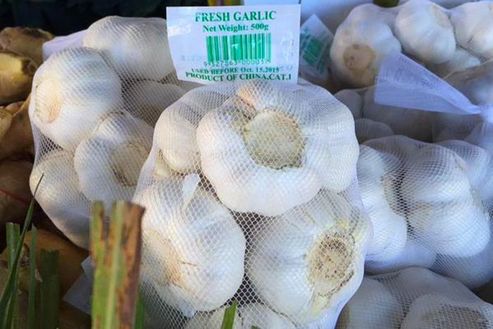





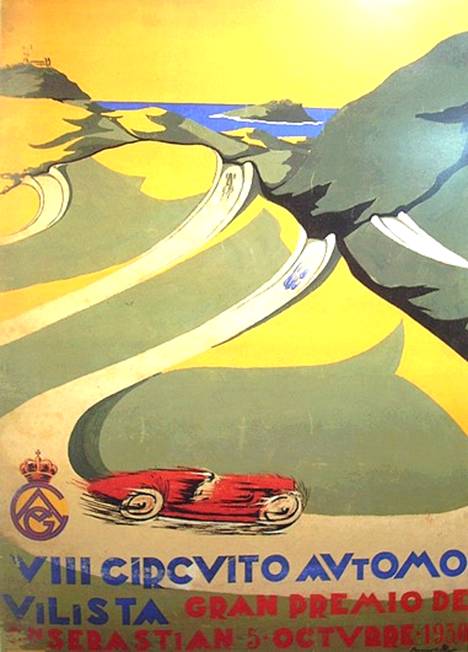


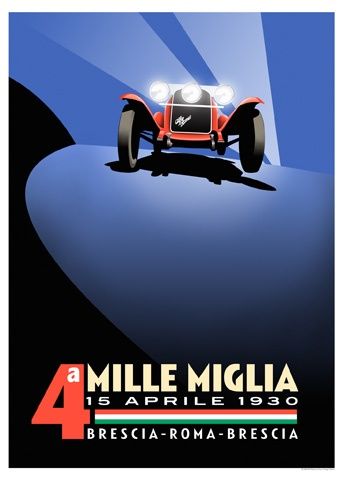

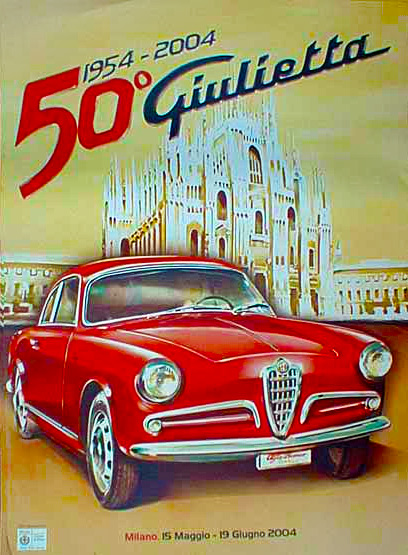
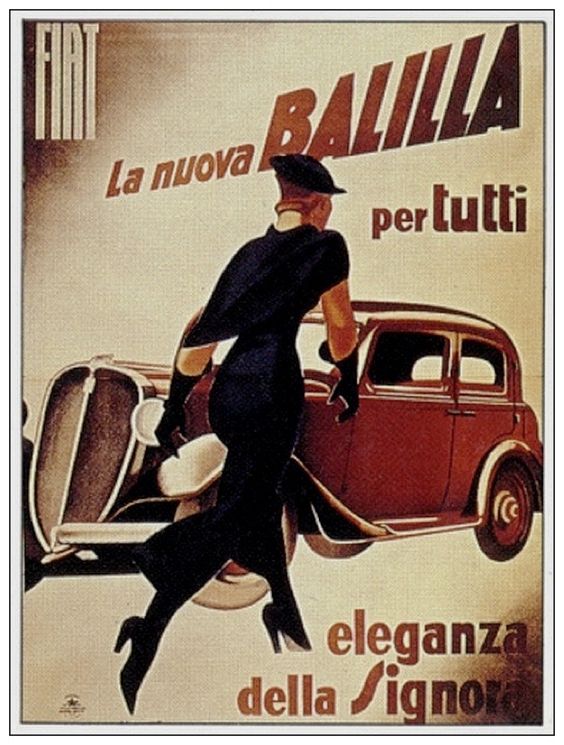



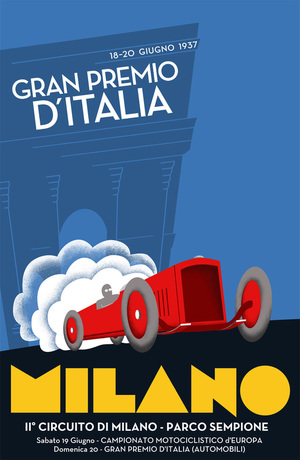
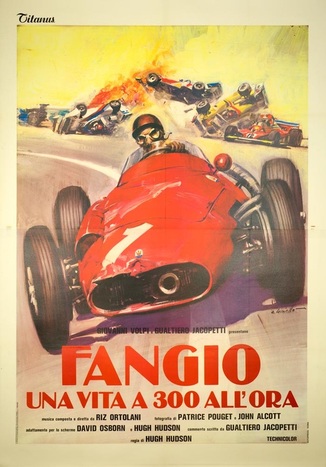

























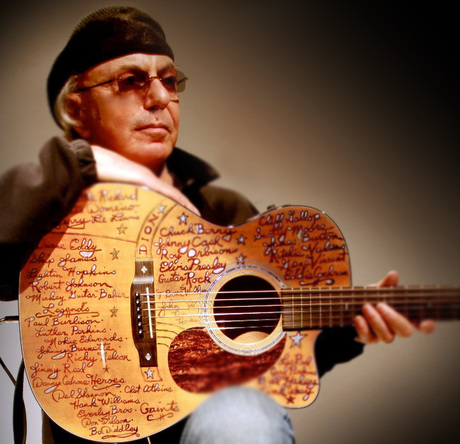











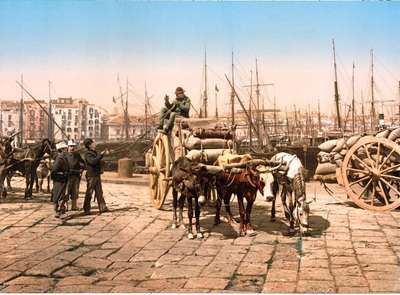



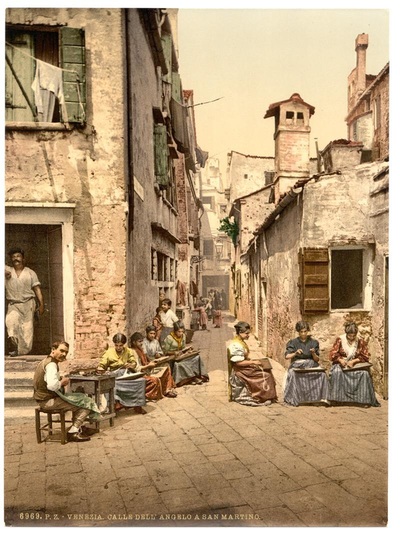






















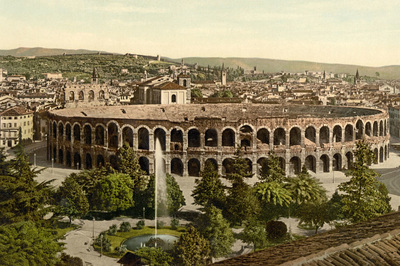





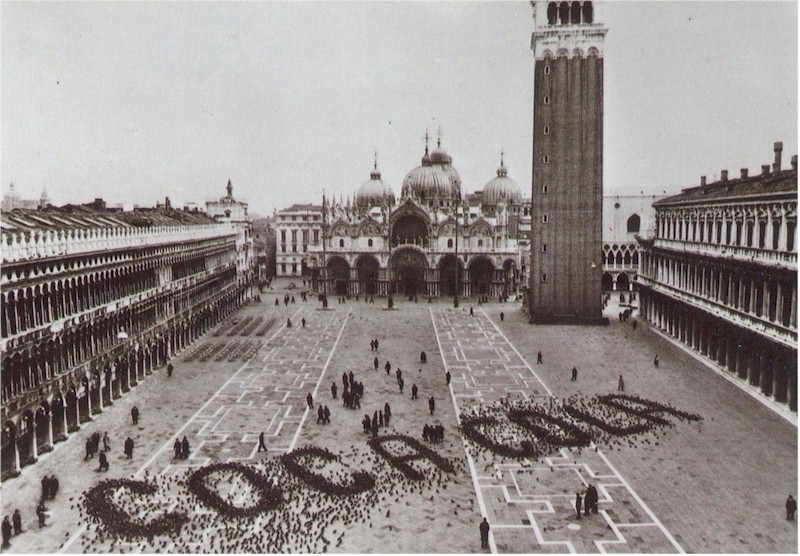











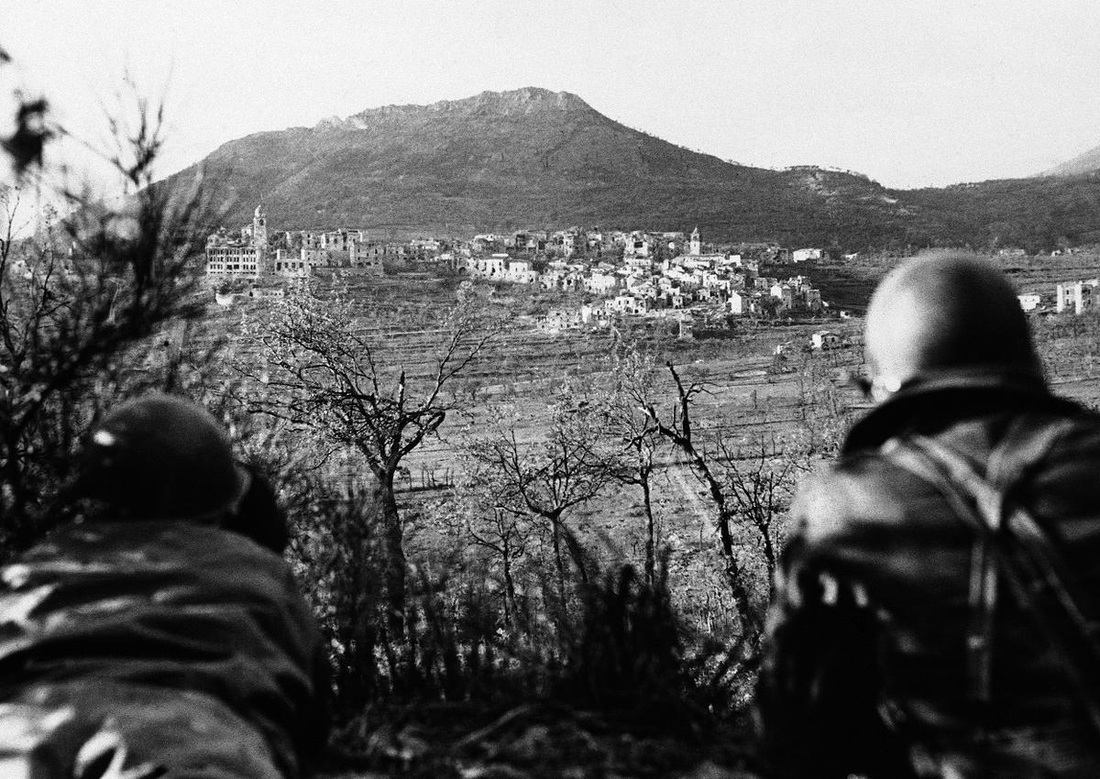











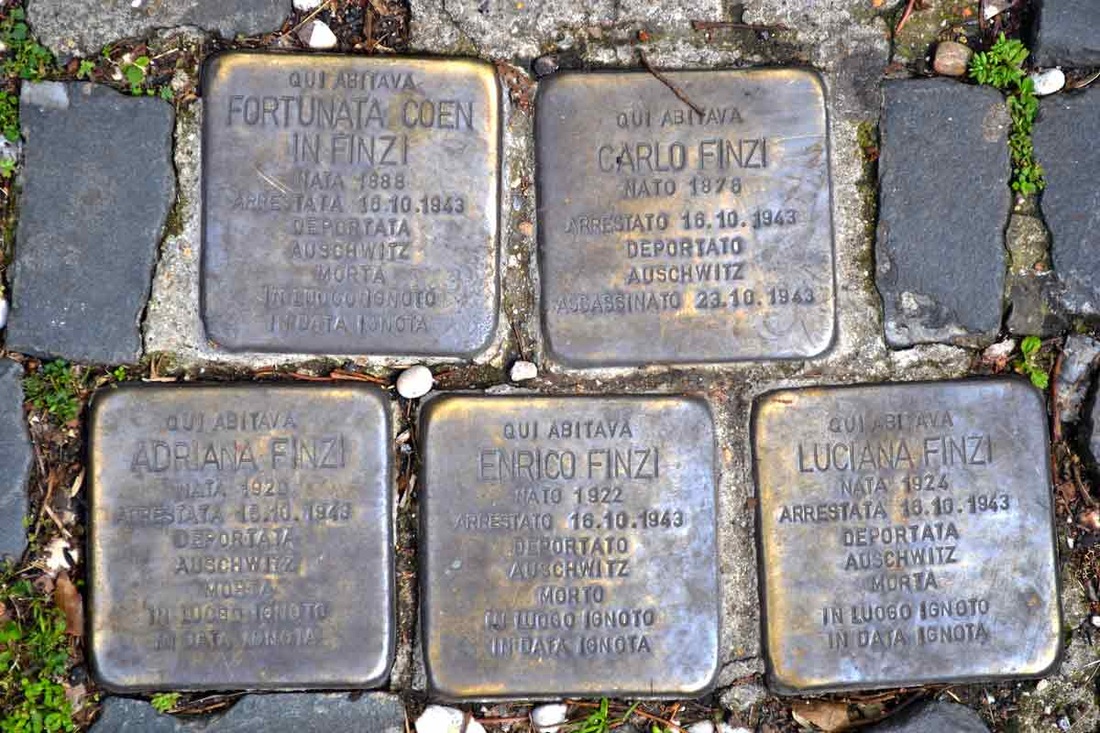
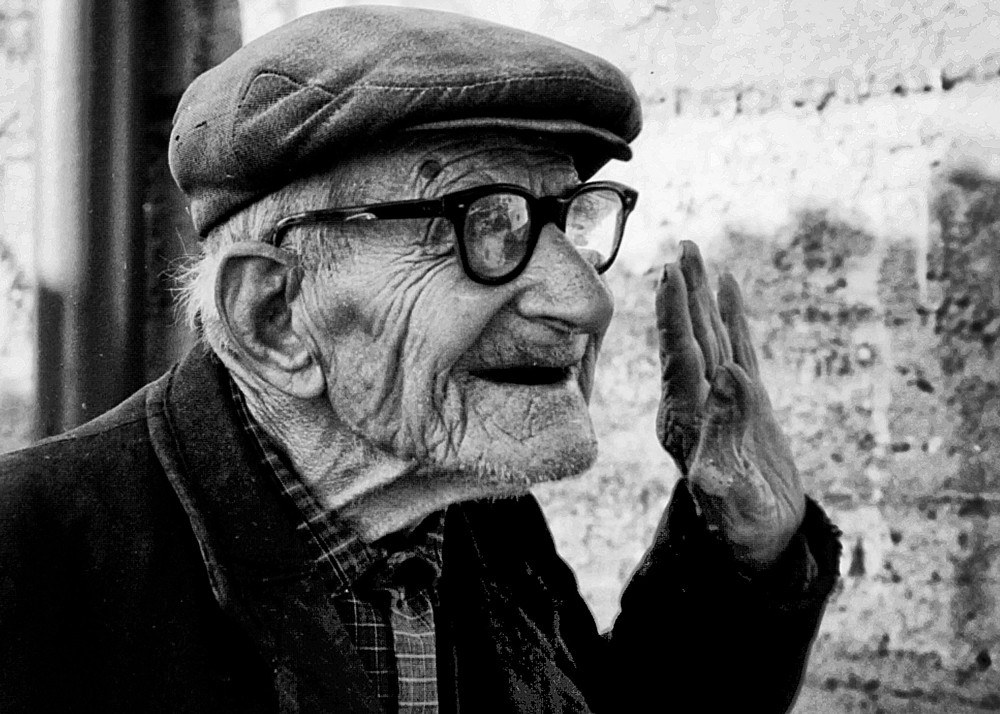

 RSS Feed
RSS Feed
